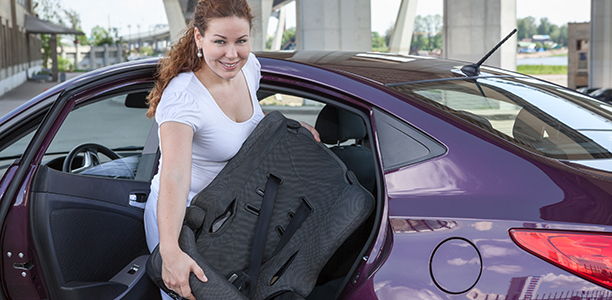Once you have chosen the right type of car seat for your baby or child, you’ll need to put aside time to install it correctly in your car, and secure your child safely in it every time you drive. It is not always an easy task and a significant proportion of parents who use car seats install them incorrectly, increasing the risk that their child will be injured if there is an accident.
Where should the car seat go?
Children are always safer in the back seat compared to the front, and it is recommended that they do not travel in the front seat until they are at least 12 years of age. It is a legal requirement for children under seven years of age to travel in the back seat, unless it is already full with younger children.
If possible, install the car seat in the middle of the back row of seats. This is the safest place for a child to sit. However, if your car only has a lap belt in the middle seat (the belt does not have a strap that goes over the shoulder), the left and right sides seats are safer.
Depending on the size of your vehicle, you can fit up to three child restraints in the back seat. But you’ll need to make sure there’s a separate anchor point for each seat.
When selecting the right position for the car seat in a station wagon with more than two rows of seats, bear in mind that extra seats in the back (sometimes referred to as dicky seats) are not suitable for car seats. Similarly, side facing seats such as those found in the back of “troop carrier” four wheel drives are not suitable for child restraints.
If you drive a vehicle with a single row of seats, it is legal to travel with a child in an age appropriate booster in the front seat. This is safest if you adjust the seat as far back as possible. However, children under four years of age should never sit in the front seat and children under twelve years of age should avoid sitting in a front seat with an airbag whenever possible.
Correct installation
A car seat that is not installed correctly can shift or become dislodged in an accident. It will not protect your child, so it is important to spend some time installing the seat correctly.
Always install a car seat according to the manufacturer’s instructions. The first thing to check is that the seat in which you plan to install your child’s restraint is suitable. Some vehicles have seats which are unsuitable for child restraints, such as extra seats in the back of a station wagon.
Attaching the top of the car seat to the car’s anchor point
Rear and forward facing restraints with harnesses are designed to be anchored to your vehicle from the top. Not all booster seats have a top anchor strap, but if they do, it is a legal requirement that it is tethered to the car.
If your child’s car seat is designed to be anchored to the car, you may need to refer to your vehicle owner’s manual to find the correct anchor point and how to attach the car seat securely to it.
When you have installed the car seat, check that the anchor strap or tether is fastened tightly. There should be no slack. Place any excess strap or webbing in a position where your child cannot reach it and it cannot fall out of the car door.
Fastening the bottom of the car seat with the car’s seat belt
When the top of the child restraint is tethered, it’s time to attach the bottom of the restraint to the car using the seat belt.
Rear and forward facing restraints are designed to be fixed at the bottom, using the car seat belt. They come with instructions to guide you to position the seat belt correctly. Typically, there is a colour coded seat belt path which shows you how to feed the seat belt through the restraint. Follow the instructions carefully.
Booster seats are used in conjunction with the car’s lap and sash seat belts, and they should not be used in seats with just a lap seat belt. Follow the instructions which came with the booster seat when positioning the seat belt (the seat belt path) exactly. Never place the sash strap of the belt underneath your child’s arm. The correct and safe position is above their shoulder. The lap portion of the belt should sit low on your child’s hips.
When you have attached the bottom of the child restraint using the seat belt, ensure the straps are tight and do not move or slacken when you push them. Check the top tether again to ensure it is still firm.
Attaching to ISOFIX anchorage points
ISOFIX anchorage systems exist in some cars in Australia, and are an alternative method of installing the car seat in the car. ISOFIX anchorage devices are metal bars which are installed in cars to anchor the bottom tether strap of a car seat. ISOFIX anchorage devices must be used in conjunction with a top-tether strap. Like other anchorage points, it is important to follow manufacturer’s instructions carefully when attaching car seat tethers to them.
If in doubt, seek help
If you have problems with the installation or any doubts about whether your child’s car seat is properly installed, visit an accredited installation service for advice and assistance before you travel with your child in the car. Even if you are confident with your installation, it is recommended that you have it checked by an approved child restraint fitter.
Fitting multiple restraints
For growing families, it can be a tricky task to fit all of your children into your car. It is important that if you have multiple children in your vehicle at the same time that all of the children are properly restrained in the correct child seat. If the availability of lap-sash seat belts is limited, these positions should be used for children in booster seats or seat belts ahead of children in forward or rear facing restraints. You should make sure that there are no interactions between any of the installed child restraints. It can be possible to fit three restraints across the back seat of some vehicles, but this will depend on the types of restraints you are using, as well as the size of your vehicle. It is important to remember that for any restraints with top tether straps, there needs to be a corresponding number of anchorage points.
Don’t use car seat accessories
Car seat accessories are any add-ons that are not part of the device sold by a manufacturer and are not recommended. They include buckle covers, seat belt tensioners and extenders, and chest clips designed to prevent a child removing their arms from the shoulder straps. It is better to teach your child not to release themselves from the restraint. Sun shades that cover the car seat are also not recommended.
References
- Tasmanian Government. Child restraints: A guide to car seats. 2015 (cited 30 July 2015). Available from: [URL link]
- Neuroscience Research Australia. Babies to benefit from NeuRA research. 2011 (cited 23 May 2017). Available from: [URL link]
- Government of South Australia. Road rules: Seat belts and child restraints. 2015 (cited 10 August 2015). Available from: [URL link]
- New South Wales Government. Child car seats. 2015 (cited 30 July 2015). Available from: [URL link]
- Vic Roads. Frequently asked questions about child restraints. 2015 (cited 30 July 2015). Available from: [URL link]
- Neuroscience Research Australian and Kidsafe. Best practice guideline for the safe restraint of children travelling in motor vehicles. 2013 (cited 13 August 2015). Available from: [URL link]
- Queensland Government. Child restraints. 2016 (cited 23 May 2017). Available from: [URL link]
- Australian Government. Safety standard: Child restraint systems for use in motor vehicles. 2014 (cited 30 July 2015). Available from: [URL link]











